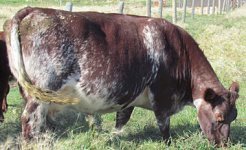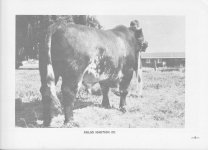I have believed for a long time, that all breeds need to be addressing calving ease more than just birth weights. Ease of calving is not just determined by the birth weight, however birth weight is an obvious factor involved. Dr. Martin Nold told me once that if you add an inch to the middle of an 1100 lb finished steer, you would add 80 lbs to it's overall weight. He said that if you took two identical animals, with the only difference being one was 1 inch longer bodied, the longer one would, on average be 80 lbs heavier. We used to talk a lot about calving ease, and he always said if we just wanted to select lower birth weights, the fastest way to do it was to select for shorter made cattle. He said that if everyone did this, we would not necessarily reduce calving ease even though we had lower birth weights.
I made many many trips to see the Weston herd, and it was an amazing herd. We would sometimes drive through the herd in his truck but there were a few times that we would saddle some horses and ride through the pastures. Martin Nold is a very intelligent veterinarian and cattle breeder. He was far ahead of many breeders in his thinking, that some considered him to be a radical. In some ways, he was a often "outside the box" and some of his methods of advancing his herd and his vet practice got him in some hot water occasionally. I mentioned in a previous post awhile ago, about a bull named Sandy Creek Ivor that we purchased in Denver. I sent him to Nold's to be export tested rather than send him back to Illinois, as Nolds was only about a 7 hour drive for me. I remember asking Martin if he had some place he could quarantine Ivor while he was being tested and he said that would be no problem. The following spring he asked me if I would sign 21 registration applications as owner of the bull. He obviously had "quarantined" the bull with a pasture of cows. Some of his " unconventional" ways of doing things eventually resulted in all the registration papers of this herd being pulled by the ASA. The same thing happened in his veterinarian practice when his vet license was pulled on occasion. He told me once that the only way he could get a load of Hereford heifers to all pass their export tests was to pull all the blood samples from one cow.
In regards to the question of whether the Shorthorn breed is a maternal or terminal, I think this breed is first and foremost a maternal breed. That said, I do also believe that this breed also has animals that do more than one thing very well, and we do have some lines that can go against the norm and do many things very well. We have always been taught that muscling and maternal traits such a milking ability are antagonistic to each other. In most cases this is very much the case, however, I have seen some Shorthorn genetics that can do both very well. This is a huge topic and I doubt if we can every cover it all adequately on here without writing a virtual book on it.
Secondly, for the most part, mating two extremes is not the preferred method of designing a reliable breeding animal, but again, I have seen cases where it has worked well. I have also said that this breed should have no reason to go outside to another breed to get a heifer safe bull to use on heifers. Unfortunately, calving issues are usually placed on the sire, but I maintain that some of the calving issues we are seeing in our heifers are " man made". By this I maintain that our breeders have created some of these problems by designing females with a certain look that goes against the way Mother Nature intended a female to look like. I remember asking Jim Williams of V8 ranch in Texas, if they had calving ease bulls in the Brahman breed. He said the beauty of the Brahman cow was that she could be bred to an elephant and still have no calving issues. He said if you study the shape of the Brahman breed, you would see why. They are designed with a lower pin bone setting than most other breeds, much similar to other animals in nature, such as a deer, elk or moose. I have often wondered if our pursuit of the big square hip on our females, especially in the show ring, has ended up in our designing a female that is not equipped to calve as easily unassisted. I also think we need to spend far more time working on gestation length in our cattle. When we imported our first Irish cattle, I noticed that my cows bred to IDS Duke of Dublin calved much later than those bred to Highfield Irish Mist. I started to document gestation length between the two bulls and found that there was, on average 11 or 12 days difference on calving dates between them. While we never had calving issues from either bull, the Duke calves were definitely bigger at birth. The easiest calving bull I have ever used on my heifers, was a full Irish bull I bred named HC Mist's Return 13R. I used him for 5 years on my heifers and usually had 15-25 calves each year sired by him from heifers. In 5 calf crops, I only assisted two heifers calve. One was a malpresentation and the other was a " convenience pull" as I had a meeting to go to. Mist's Return has the shortest gestation length I have ever found in a Shorthorn bull. As he was used in a pasture breeding situation, I did not get breeding dates on every heifer, but I kept track of as any I saw him with, and I learned I better be ready for some births at least 12 days before the normal predicted calving date in most calving books. I still use him on some heifers every year. This is much the same for Ready Go, a bull bred by Martin Nold, that we purchased 41 years ago. Even though, it is now 41 years since we purchased him, we still are selling semen from him. Our semen supply is getting down, but we were fortunate in that a few thousand doses of semen were collected at no cost to us, by the stud to market in South America. After they never got paid for the first 600 doses that went down there, they ended up just giving me the semen if I paid the storage on it. He is the only bull I have owned that I have continued to sell semen from every year since we bought him. Some breeders have told me that he is the best bull they have ever used for using on their heifers and one breeder has used him now for at least 25 years to breed some heifers to.
Getting back to the discussion on sires suitable to use on heifers, I think we could have found a lot of solutions to this issue if we are breeders could simply track gestation length more accurately and identify sires that have a short gestation length. I think we would be able to produce so called "heifer bulls" in quantity if we only did this.
I will try to get back to give some thoughts on the other questions brought up, but right now, I have to tend to some critters.


















